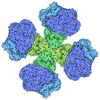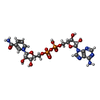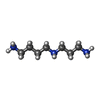[English] 日本語
 Yorodumi
Yorodumi- PDB-8qzx: CryoEM structure of DHS-eIF5A complex structure from Trichomonas ... -
+ Open data
Open data
- Basic information
Basic information
| Entry | Database: PDB / ID: 8qzx | |||||||||
|---|---|---|---|---|---|---|---|---|---|---|
| Title | CryoEM structure of DHS-eIF5A complex structure from Trichomonas vaginalis | |||||||||
 Components Components |
| |||||||||
 Keywords Keywords | TRANSLATION / parasite / hypusination / eI5FA / hypusine / DHS / Trichomonas vaginalis / deoxyhypusination / translation factor | |||||||||
| Function / homology |  Function and homology information Function and homology informationdeoxyhypusine synthase / deoxyhypusine synthase activity / spermidine metabolic process / positive regulation of translational termination / positive regulation of translational elongation / translation elongation factor activity / translation initiation factor activity / ribosome binding / RNA binding / cytoplasm Similarity search - Function | |||||||||
| Biological species |  Trichomonas vaginalis (eukaryote) Trichomonas vaginalis (eukaryote) | |||||||||
| Method | ELECTRON MICROSCOPY / single particle reconstruction / cryo EM / Resolution: 3.01 Å | |||||||||
 Authors Authors | Wator, E. / Wilk, P. / Grudnik, P. | |||||||||
| Funding support |  Poland, 2items Poland, 2items
| |||||||||
 Citation Citation |  Journal: FEBS J / Year: 2024 Journal: FEBS J / Year: 2024Title: Structural characterization of the (deoxy)hypusination in Trichomonas vaginalis questions the bifunctionality of deoxyhypusine synthase. Authors: Elżbieta Wątor / Piotr Wilk / Paweł Kochanowski / Przemysław Grudnik /  Abstract: Trichomonas vaginalis, the causative agent of trichomoniasis, is a prevalent anaerobic protozoan parasite responsible for the most common nonviral sexually transmitted infection globally. While ...Trichomonas vaginalis, the causative agent of trichomoniasis, is a prevalent anaerobic protozoan parasite responsible for the most common nonviral sexually transmitted infection globally. While metronidazole and its derivatives are approved drugs for this infection, rising resistance necessitates the exploration of new antiparasitic therapies. Protein posttranslational modifications (PTMs) play crucial roles in cellular processes, and among them, hypusination, involving eukaryotic translation factor 5A (eIF5A), has profound implications. Despite extensive studies in various organisms, the role of hypusination in T. vaginalis and its potential impact on parasite biology and pathogenicity remain poorly understood. This study aims to unravel the structural basis of the hypusination pathway in T. vaginalis using X-ray crystallography and cryo-electron microscopy. The results reveal high structural homology between T. vaginalis and human orthologs, providing insights into the molecular architecture of eIF5A and deoxyhypusine synthase (DHS) and their interaction. Contrary to previous suggestions of bifunctionality, our analyses indicate that the putative hydroxylation site in tvDHS is nonfunctional, and biochemical assays demonstrate exclusive deoxyhypusination capability. These findings challenge the notion of tvDHS functioning as both deoxyhypusine synthase and hydroxylase. The study enhances understanding of the hypusination pathway in T. vaginalis, shedding light on its functional relevance and potential as a drug target, and contributing to the development of novel therapeutic strategies against trichomoniasis. | |||||||||
| History |
|
- Structure visualization
Structure visualization
| Structure viewer | Molecule:  Molmil Molmil Jmol/JSmol Jmol/JSmol |
|---|
- Downloads & links
Downloads & links
- Download
Download
| PDBx/mmCIF format |  8qzx.cif.gz 8qzx.cif.gz | 292.2 KB | Display |  PDBx/mmCIF format PDBx/mmCIF format |
|---|---|---|---|---|
| PDB format |  pdb8qzx.ent.gz pdb8qzx.ent.gz | 237.4 KB | Display |  PDB format PDB format |
| PDBx/mmJSON format |  8qzx.json.gz 8qzx.json.gz | Tree view |  PDBx/mmJSON format PDBx/mmJSON format | |
| Others |  Other downloads Other downloads |
-Validation report
| Summary document |  8qzx_validation.pdf.gz 8qzx_validation.pdf.gz | 1.8 MB | Display |  wwPDB validaton report wwPDB validaton report |
|---|---|---|---|---|
| Full document |  8qzx_full_validation.pdf.gz 8qzx_full_validation.pdf.gz | 1.8 MB | Display | |
| Data in XML |  8qzx_validation.xml.gz 8qzx_validation.xml.gz | 59.3 KB | Display | |
| Data in CIF |  8qzx_validation.cif.gz 8qzx_validation.cif.gz | 87.5 KB | Display | |
| Arichive directory |  https://data.pdbj.org/pub/pdb/validation_reports/qz/8qzx https://data.pdbj.org/pub/pdb/validation_reports/qz/8qzx ftp://data.pdbj.org/pub/pdb/validation_reports/qz/8qzx ftp://data.pdbj.org/pub/pdb/validation_reports/qz/8qzx | HTTPS FTP |
-Related structure data
| Related structure data |  18784MC 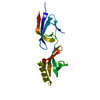 8qzvC 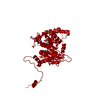 8qzwC M: map data used to model this data C: citing same article ( |
|---|---|
| Similar structure data | Similarity search - Function & homology  F&H Search F&H Search |
- Links
Links
- Assembly
Assembly
| Deposited unit | 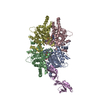
|
|---|---|
| 1 |
|
- Components
Components
| #1: Protein | Mass: 40489.102 Da / Num. of mol.: 4 / Mutation: K332A Source method: isolated from a genetically manipulated source Source: (gene. exp.)  Trichomonas vaginalis (eukaryote) / Gene: TVAG_359990 / Production host: Trichomonas vaginalis (eukaryote) / Gene: TVAG_359990 / Production host:  #2: Protein | | Mass: 18430.594 Da / Num. of mol.: 1 Source method: isolated from a genetically manipulated source Source: (gene. exp.)  Trichomonas vaginalis (eukaryote) / Gene: eIF-5A1 / Production host: Trichomonas vaginalis (eukaryote) / Gene: eIF-5A1 / Production host:  #3: Chemical | ChemComp-NAD / #4: Chemical | Has ligand of interest | Y | Has protein modification | N | |
|---|
-Experimental details
-Experiment
| Experiment | Method: ELECTRON MICROSCOPY |
|---|---|
| EM experiment | Aggregation state: PARTICLE / 3D reconstruction method: single particle reconstruction |
- Sample preparation
Sample preparation
| Component | Name: Complex of DHS-eIF5A / Type: COMPLEX / Entity ID: #1-#2 / Source: RECOMBINANT | |||||||||||||||
|---|---|---|---|---|---|---|---|---|---|---|---|---|---|---|---|---|
| Molecular weight | Experimental value: NO | |||||||||||||||
| Source (natural) | Organism:  Trichomonas vaginalis (eukaryote) Trichomonas vaginalis (eukaryote) | |||||||||||||||
| Source (recombinant) | Organism:  | |||||||||||||||
| Buffer solution | pH: 9.3 | |||||||||||||||
| Buffer component |
| |||||||||||||||
| Specimen | Conc.: 0.5 mg/ml / Embedding applied: NO / Shadowing applied: NO / Staining applied: NO / Vitrification applied: YES | |||||||||||||||
| Specimen support | Grid type: Quantifoil R2/2 | |||||||||||||||
| Vitrification | Instrument: FEI VITROBOT MARK IV / Cryogen name: ETHANE / Humidity: 100 % / Chamber temperature: 278 K |
- Electron microscopy imaging
Electron microscopy imaging
| Experimental equipment |  Model: Titan Krios / Image courtesy: FEI Company |
|---|---|
| Microscopy | Model: FEI TITAN KRIOS |
| Electron gun | Electron source:  FIELD EMISSION GUN / Accelerating voltage: 300 kV / Illumination mode: FLOOD BEAM FIELD EMISSION GUN / Accelerating voltage: 300 kV / Illumination mode: FLOOD BEAM |
| Electron lens | Mode: BRIGHT FIELD / Nominal defocus max: 3500 nm / Nominal defocus min: 500 nm / Cs: 2.7 mm |
| Specimen holder | Cryogen: NITROGEN |
| Image recording | Electron dose: 40 e/Å2 / Film or detector model: GATAN K3 (6k x 4k) |
- Processing
Processing
| EM software |
| ||||||||||||||||||||||||
|---|---|---|---|---|---|---|---|---|---|---|---|---|---|---|---|---|---|---|---|---|---|---|---|---|---|
| Image processing | Details: selected images were normalized and low-pass filtered | ||||||||||||||||||||||||
| CTF correction | Type: PHASE FLIPPING AND AMPLITUDE CORRECTION | ||||||||||||||||||||||||
| Particle selection | Num. of particles selected: 1157408 / Details: template picking | ||||||||||||||||||||||||
| Symmetry | Point symmetry: C1 (asymmetric) | ||||||||||||||||||||||||
| 3D reconstruction | Resolution: 3.01 Å / Resolution method: FSC 0.143 CUT-OFF / Num. of particles: 422161 / Algorithm: FOURIER SPACE / Num. of class averages: 1 / Symmetry type: POINT | ||||||||||||||||||||||||
| Atomic model building | Protocol: RIGID BODY FIT / Space: REAL | ||||||||||||||||||||||||
| Atomic model building | PDB-ID: 8A0E Accession code: 8A0E / Source name: PDB / Type: experimental model | ||||||||||||||||||||||||
| Refine LS restraints |
|
 Movie
Movie Controller
Controller



 PDBj
PDBj
